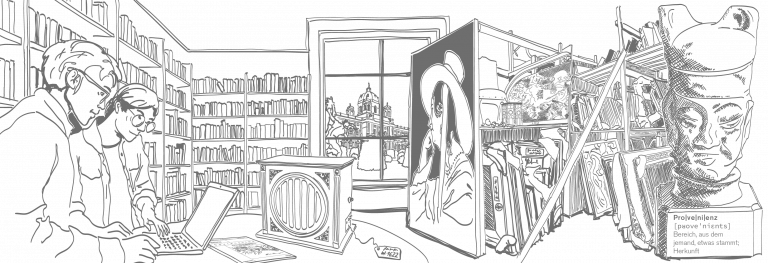PROJECTS
PROJECTS
Apart from applied research, in other words the systematic research in the collections and the compiling of dossiers for the Art Restitution Advisory Board, members of the Commission for Provenance Research also make a significant contribution to fundamental research. Digitization, publications and specific research projects help expand knowledge of asset confiscations as a result of Nazi persecution and also foster international networking and the professionalization of Nazi-related provenance research and make the results of the Commission for Provenance Research’s work more accessible. You can find out here about current and completed projects carried out by the Commission on its own or in cooperation with partners.
>> Culture project of the European Capital of Culture Bad Ischl Salzkammergut 2024
The unheard-of things: A different kind of provenance research
>> Lexicon of Austrian Provenance Research
>> Online Edition – records from the Central Depot for Seized Collections in Vienna
>> Database of provenance markings
>> The art market as illustrated by the Federal Monuments Authority export forms and documents from 1938 to 1945 and the role of transporters in that context
>> Basic research project on the >> “Aryanization” of the Vienna clock, watch and jewellery sector
>> TransCultAA – Transfer of Cultural Objects in the Alpe Adria Region in the 20th Century
culture project of the European Capital of Culture Bad Ischl Salzkammergut 2024
The unheard-of things: A different kind of provenance research
This theatre performance is about looted art and everyday objects from former Jewish property in the region. At weekly markets in Altaussee and Bad Aussee, the audience can watch and listen to four women as they make a radio broadcast in the hustle and bustle of the market, focussing on the stories that can be linked to these objects. The “entertainment programme” genre opens up a wide range of possibilities for conveying the topic with the necessary ease: Interviews, request concerts, live singing, contact with people at the market, appeals, competitions, or even interviews with experts and live guests. The focus is on objects that were previously discovered and selected in the course of research. The performance project invites residents and visitors to the Salzkammergut to come to terms with Nazi looting, provenance and restitution, with questions of loss, the emotional value of things and remembrance or non-memory, and also with decades of silence – in an unusual way.
Project duration: 2019 to 2024 (idea, concept and project development), the theatre performances took place in August and September 2024, further performances are planned
Funding: Salzkammergut 2024 European Capital of Culture, Commission for Provenance Research
Project team: A project by Theater im Bahnhof (Graz) with Monika Löscher (Commission for Provenance Research) and Birgit Johler (Volkskundemuseum am Paulustor, Universalmuseum Joanneum) as part of the European Capital of Culture Bad Ischl Salzkammergut 2024. Based on an idea by Monika Löscher
Websites: https://www.salzkammergut-2024.at/projekte/die-unerhoerten-dinge/, https://www.theater-im-bahnhof.com/de/production/die-unerhoerten-dinge
Lexicon of Austrian Provenance Research
Based on the concept developed by Pia Schölnberger and Leonhard Weidinger, the Lexicon of Austrian Provenance Research collates the knowledge acquired since 1998 by members of the Commission for Provenance Research and by provenance researchers from other institutions. It has entries about persons, places, companies and institutions that were connected with museums and collections, culture policy or trade in art and cultural objects in Austria between 1930 and 1960. The articles cover asset confiscations during the Nazi period, biographies and career histories, document the institutional context and structures, and examine post-war restitution practice.
The Lexicon will be continuously enlarged and supplemented. Starting with just under 200 entries published in early 2019, by October 2020 a total of 295 entries could be consulted online. The website is to be relaunched at the end of 2020, and some of the entries will be available in English, with further texts in English to follow in 2021.
Project duration: 2014 to 2018 (idea, conception and project development), since 2019 online, continuous updating
Financing: Commission for Provenance Research
Project team: Pia Schölnberger and Leonhard Weidinger (conception and editing until 2017), Konstantin Ferihumer and Susanne Hehenberger (editing since 2018), Leonhard Weidinger (technical consultant), Nick Somers (English translations)
Link:www.lexikon-provenienzforschung.org
Online Edition – records from the Central Depot for Seized Collections in Vienna
In December 2017 the Commission for Provenance Research and the Kunsthistorisches Museum (KHM) archive published around 11,500 file cards created in 1938/39 in the Zentraldepot für beschlagnahmte Sammlungen (Central Depot for Seized Collections) in the Neue Burg in Vienna. The files contain a record of objects confiscated by the Nazi regime from Viennese art collections and brought to the Central Depot from autumn 1938 for subsequent distribution to various museums, including the planned art museum in Linz. These confiscated artworks were administered until July 1940 by the Kunsthistorisches Museum and thereafter by the Institut für Denkmalpflege (Institute for Monument Protection), now the Bundesdenkmalamt (Federal Monuments Authority – BDA) in Vienna, which also continued to use the file cards for records after 1945. The idea behind the Online Edition of the Central Depot files was to create a combined digital database of the separate BDA and KHM sources and to make the data available to researchers and the general public.
The database has already produced results. Following the systematic scanning of published file cards and photos, a Pettenkofen watercolour held by the Albertina since 1963 was identified fifty-five years after its confiscation from the Louis Rothschild collection. In June 2018, the Art Restitution Advisory Board recommended its restitution.
Accompanying texts have been available in English since summer 2018. In 2019 a further 400 cards were discovered during an inventory of the KHM archive and added to the Online Edition. In 2020, a comparison was made with a further 122 photos of various origins in the KHM archive showing individual objects or groups of objects from the seized collections. They include paintings, drawings, artefacts, weapons and armour from the Aldor, Altmann, Goldmann, Gutmann, Haas, Kornfeld, Kulka, Pilzer, A. and L. Rothschild and Thorsch collections and were evidently photographed at different times. Blog entries have been created for 170 object numbers from the Central Depot with links to the photos now published in the KHM’s online collection. Thanks to the assistance of members of the research community, additional information has been obtained on around 600 object numbers.
Project duration: October 2015 to December 2017, continuous updating
Financing: Commission for Provenance Research and Kunsthistorisches Museum Wien
Project team: Lisa Frank (Commission for Provenance Research), Susanne Hehenberger (project coordination, KHM), Peter Kloser (KHM), Leonhard Weidinger (Commission for Provenance Research)
Cooperation partners: Commission for Provenance Research, Kunsthistorisches Museum Wien, Federal Monuments Authority
Link: www.zdk-online.org
Database of provenance markings
The database of provenance markings, developed by René Schober and Christina Gschiel and managed since 2016 by Julia Eßl, is designed for the documentation, collection and investigation of markings on museum objects (e.g. on the back or frame of paintings and drawings, or on the bottom of applied art objects). The findings of expert appraisals (autopsies) are linked to the data from the mounting in a specially designed database, which facilitates the collection and comparison of provenance markings and the identification of the former owners.
Typical markings include export stamps, company stamps, museum stamps, exhibition labels/stamps, gallery labels/stamps, estate stamps, inscriptions, inventory stamps, numbers/letters, bookplates, consignment
numbers or customer stamps/seals.
Thanks to the online accessibility of these data, knowledge and information can be rapidly exchanged. The database is subject to registration and all data entered into it are accessible only to users with a justified interest in them.
As at September 2020 the database of provenance markings contained around 900 entries.
Project duration: May 2010 to December 2011, continuous updating
Financing: Commission for Provenance Research
Project team: René Schober and Christina Gschiel (2010–2016), Julia Eßl (since 2016)
Link: provenienz.collectiveaccess.eu
The art market as illustrated by the Federal Monuments Authority export forms and documents from 1938 to 1945 and the role of transporters in that context
Under the 1918 Austrian Export Prohibition Act and the 1923 Protection of Monuments Act, the export of valuable art objects from Austria was strictly regulated. This legislation was exploited during the Nazi era to block the export of valuables belonging to persecutees. After the war, it was also used to force victims, most of whom now lived abroad, to donate or sell to museums artworks coming under the export prohibition, in return for the permission to export other items. Between 1938 and 1945, around 18,000 export applications were made, the vast majority in 1938. The forced emigration of the Jews and their dispossession were the main reason for the enormous increase in applications after the annexation of Austria to Nazi Germany.
In this project financed by the Commission, the names of the applicants and other details were first entered in an Excel table and the data then analysed. A very large number of cultural objects were exported to Germany from art dealerships in Austria, mostly to dealerships in Germany. Because of the vague descriptions of the objects in many cases, it is often difficult to determine whether the goods were confiscated or sold under pressure. The enormous increase in applications would suggest a close connection with the anti-Jewish measures. At all events, non-Jewish art dealers made large profits. In an extension of the project, an important aspect has been added, namely the role of logistics companies (transport, warehouse and shipping companies) in this context.
Project duration: Phase 1: 2016–2018, Phase 2: 2018–2022
Financing: Commission for Provenance Research, co-financed by the National Fund of the Republic of Austria for Victims of National Socialism
Project team: Gabriele Anderl, Anneliese Schallmeiner
Basic research project on the “Aryanization” of the Vienna clock, watch and jewellery sector
In a coordinated and centralized campaign inaugurated shortly after the annexation of Austria to the Nazi German Reich on 10 April 1938, members of the Vienna clock, watch and jewellery sector placed the hundred largest businesses belonging to Jewish colleagues, who were now subject to persecution, under temporary administration. In spite of the absence of a legal basis at this time, they thus embarked on the rapid and systematic removal of Jews from this entire business sector.
The case study focuses both on the reconstruction of the historical events and on the subsequent attitude to them in the Second Republic. It starts with an empirical study at the microsocial level of the progress of “Aryanization” as a form of social activity by the Nazi “Volksgemeinschaft” (ethnic community) and of the identity of the main actors. This is followed by a qualitative analysis of biographical case studies to determine how Austrian society addressed the past after the Second World War in its attitude to the relics of the Nazi regime. How a society deals with the past can be seen not only at the personal, symbolic and discursive level but also in particular at the material level. It is here that provenance research and the restitution of assets expropriated during the Nazi period is situated.
Project duration: 2018–2023
Financing: Commission for Provenance Research
Project leader: Konstantin Ferihumer
TransCultAA – Transfer of Cultural Objects in the Alpe Adria Region in the 20th Century
The Commission for Provenance Research acts as associated partner in this research project
This research project is the first attempt to investigate the transfer of cultural assets in the Alpe Adria area in the 20th century. In an unprecedented transnational and collaborative way, it will engage a multinational team of scholars to analyze “Uses of the Past”, in particular historical and current conflicts of ownership, patrimony, and cultural heritage…
Link: www.transcultaa.eu/project-description/

